|
 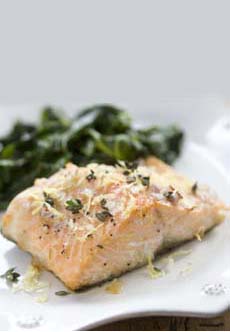
Baked Arctic char with lemon thyme and sea salt. Arctic char is related to the salmon, which is evident from the color of its flesh. Photo courtesy of Whole Foods Market.
|
| This glossary was compiled by THE NIBBLE EDITORS. It is updated regularly. William Lance Hunt, a freelance writer in New York City, contributed to the first version. |
|
October 2005
Updated October 2009
|
 |
Fish & Seafood Glossary
Page 1: Seafood Types Beginning With A
Master the terms in this glossary, and you’ll be able to hold your own with any fishmonger or professional chef. If you’d like to suggest additional words, click here. This is Page 1 of a 13-page glossary featuring different types of fish and seafood. Here, seafood types beginning with A, such as abalone, anchovy, arctic char and Atlantic oyster. Click on the links below to visit other pages. See our 60+ other food glossaries, each featuring a different favorite food.
Click on a letter to get to another section of the glossary.
a b c d e f g h i j k l m n o p q r s t u v w x y z
This glossary is protected by copyright and cannot be reproduced in whole or part.
Editor’s Note: Popular varieties can become overfished: Atlantic cod, monkfish, and bluefin tuna are three varieties that need time to repopulate. But as long as consumer demand remains at peak, fishing boats will pursue them until, like the Caspian sturgeon, they could end up on endangered species lists. SeafoodWatch.org has downloadable pocket guides of best choices in each region of the U.S. By using the guide at a supermarket or restaurant, you’re making choices that support environmentally friendly fishing.
ABALONE
A family of large edible marine gastropods having an ear-shaped shell with a row of holes along the outer edge. The colorful pearly interior of the shell (the famous “mother of pearl”) is often used for making ornaments. The abalone is normally found on rocks in kelp beds (it eats kelp). It is common to dive for abalone in water that is six to more than 20 feet deep. An eight-inch abalone is considered a good catch, nine inches extremely good, and a ten-inch plus abalone would be a trophy catch. Rock picking is a separate method from diving, where the rock picker feels underneath rocks at low tides for abalone.
|
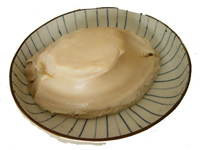
The meat of a Californian red abalone. Photo courtesy of Wikipedia. |
ALBACORE
A variety of tuna, also called white tuna, a reference to its light pink flesh. See Tuna—Albacore.
AMBERJACK
A food and game fish native to temperate and tropical marine waters. Pompano is a member of the amberjack family. The average amberjack is 40 to 50 pounds. The yellowtail kingfish (Seriola ialandi), sashimi yellowtail, is also known as amberjack. |

Photo courtesy of NCFisheries.net. |
ANCHOVY
A small saltwater fish belonging to the herring family that is native to the Mediterranean Sea and the English Channel. Typically no more than six inches in length, the anchovy is green-colored as a fresh fish, but changes to a greyish-black color when cured. Similar to a sardine in size, it is used in the same way as a sardine, in appetizers or as a seasoning or garnish in salads, soups, pasta or pizza. Anchovies are processed into filets and preserved by curing them in salt and packing them in olive oil, by pickling the filets in vinegar and oil or by preserving the filets as fresh fish. When cured, they become dark black in color and salty in flavor.
|
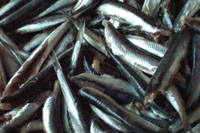
Photo courtesy of Sxc. |
Anchovies packed fresh in oil (olive or sunflower oil) and wine vinegar are referred to as white anchovies, retaining more of their white silvery color. White anchovies are fresher in age, more perishable and may not last long after being purchased. The white anchovy filets are less salty than salt-cured anchovies. Anchovies are sold either flat or rolled. Anchovy paste can be used as a substitute in recipes, with 1/2 teaspoon equating to one filet.
ANGLER FISH
This very ugly, but very tasty fish is also known as monkfish, lotte, bellyfish, frogfish, sea devil and goosefish. The name “angler” comes from the wormlike filament that grows from its head, by which it lures prey, fishing much like an angler. It has low-fat and firm-textured meat that is mild and sweet—similar to lobster; it is sometimes called “poor man’s lobster.” The only edible portion of this fish is the tail, which can be cooked in most any fish preparation.
|
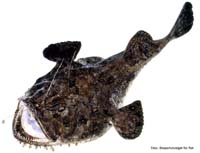
Photo courtesy of Institute for Marine Research. |
ARCTIC CHAR
The arctic char is related to both the salmon and the trout (the Mackinaw trout or lake trout is actually a char). There are both freshwater and saltwater char; both live in the icy waters of North America and Europe. Once almost exclusively a game fish, char is now farm-raised for commercial use. Government-sponsored fish farms in Iceland have made char more widely available. It has sweet and tender pink flesh with a flavor and texture that’s a cross between trout and salmon. Most often, char is prepared roasted or smoked. Salmon or striped bass are good comparisons (and substitutes).
|
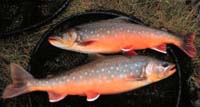
Photo courtesy of Togiak National
Wildlife Refuge. |
ATLANTIC OYSTER
Also called Eastern or East Coast oyster, this species has a thick, elongated shell that measures from two to five inches at its widest point. There are dozens of regional varieties, and most get their distinctive names based on the region. The most well-known is the ubiquitous Bluepoint oyster (originally named for an area on the southern shore of Long Island, but this has become a generic name for Atlantic oysters); there are dozens more, including Malpeque, Kent Island and Fisher Island oysters. Even though they are called Atlantic oysters, they are caught wild from Newfoundland to Colombia and in Europe, as well as on Florida’s Gulf Coast, in Australia, Chile, Japan and New Zealand. They are also farmed along the Atlantic coast of the U.S.
|
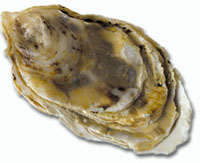
Photo courtesy of Wikipedia.
|
The taste and texture of oysters depends more on the area they are grown in than the species to which they belong, much like wine. Oysters are ideal for serving on the half shell, but can be found cured or canned. See our Oyster Glossary for more information about oysters and types of oysters.
Continue To Page 2: Seafood Terms Beginning With B
Go To The Alphabet Index Above
|










